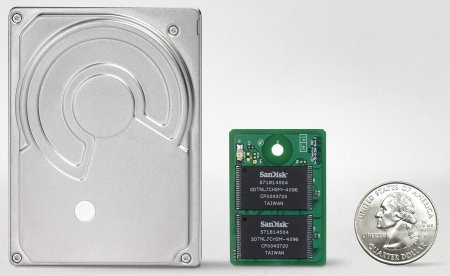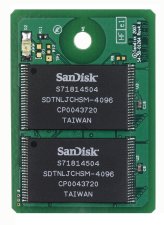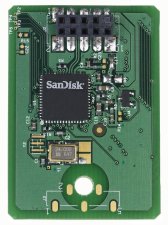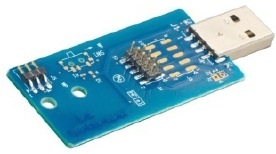Embedded flash module targets consumer devices
Aug 31, 2007 — by LinuxDevices Staff — from the LinuxDevices Archive — 2 views SanDisk has expanded its solid-state drive (SSD) product line with a module a quarter the size of 1.8-inch hard drives. The flash-based uSSD 5000 is designed to be embedded on the motherboards of low-cost PCs, such as Intel's Classmate, or other consumer devices.
SanDisk has expanded its solid-state drive (SSD) product line with a module a quarter the size of 1.8-inch hard drives. The flash-based uSSD 5000 is designed to be embedded on the motherboards of low-cost PCs, such as Intel's Classmate, or other consumer devices.

The uSSD 5000 compared to a 1.8-inch hard drive and a US quarter
(Click to enlarge)
digg this story |
The uSSD 5000 weighs less than two ounces, and is available in two slightly different form-factors: standard, and low profile. Both are approximately 1.5 inches long, and just over an inch wide. However, the standard profile is 0.42 inches (10.6 mm) thick, whereas the low-profile unit is 0.26 inches (6.6 mm) thick.


SanDisk's uSSD 5000 top (left) and bottom (right)
(Click to enlarge)
According to the company, the device is recognized as a standard, bootable hard drive via the native OS support in OSes, including “all versions” of Linux, Windows Vista, Windows XP, Windows XP Embedded, Windows CE, “all versions” of Linux, and even DOS.
 The modules employ a USB interface but, with a special 2×5 device interface connector, are not designed to be removable. As the photo at the right shows, though, SanDisk will offer some customers uSSD 5000s wired to a standard USB connector for evaluation purposes.
The modules employ a USB interface but, with a special 2×5 device interface connector, are not designed to be removable. As the photo at the right shows, though, SanDisk will offer some customers uSSD 5000s wired to a standard USB connector for evaluation purposes.
The uSSD 5000 is said to be available in a variety of capacities, ranging from 1 GB to 8 GB. The 1 GB version uses standard single-level cell (SLC) flash technology, but the 2, 4, and 8 GB versions are available either as SLC or as SanDisk's “patented, more cost-effective” multi-level cell (MLC) technology.
Though more expensive, SLC offers greater performance. SanDisk's preliminary data sheet cites the following benchmarks:
- Maximum performance for 1 GB, 2 GB, 4 GB, and 8 GB (SLC configurations):
- Sequential read, 31.6 MB/sec
- Sequential write, 24.8 MB/sec
- Random read @ 4 KB access, 5.7 MB/sec
- Random write @ 4 KB access, 1.2 MB/sec
- Sequential read, 31.6 MB/sec
- Maximum performance for 2 GB, 4 GB, and 8 GB (MLC configurations):
- Sequential read, 29.9 MB/sec
- Sequential write, 12.8 – 9.0 MB/sec (varies with capacity)
- Random read @ 4 KB access, TBD
- Random write @ 4 KB access, TBD
- Sequential read, 29.9 MB/sec
SanDisk claims the uSSD 5000 modules will be reliable in even the most challenging environments. “Dynamic bad block management, dynamic and static wear-leveling, and robust error detection and correction code (EDC/ECC) ensure data reliability,” according to the data sheet.
With respect to “endurance” — how long flash memory will last with repeated rewrites — SLC again comes out ahead of MLC. SanDisk says that during a three-year period, users could update the entire device six times daily, on average. In other words, 48 GB of data could be read or written daily to an SLC-based 8 GB uSSD 5000. In contrast, the MLC technology is said to permit updating only 25 percent of the device, once a day.
Availability
Without releasing specific pricing, SanDisk said in a statement that 2 GB configurations of the uSSD 5000 would be appropriate to $250 PCs. The modules will be “significantly less expensive than even the lowest-capacity conventional hard disk drives,” the company added.
SanDisk says the uSSD 5000 will be available in sample quantities by the end of September, with volume availability expected in the fourth quarter.
This article was originally published on LinuxDevices.com and has been donated to the open source community by QuinStreet Inc. Please visit LinuxToday.com for up-to-date news and articles about Linux and open source.